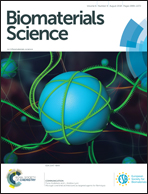Effect of ionic strength on shear-thinning nanoclay–polymer composite hydrogels†
Abstract
Nanoclay–polymer shear-thinning composites are designed for a broad range of biomedical applications, including tissue engineering, drug delivery, and additive biomanufacturing. Despite the advances in clay–polymer injectable nanocomposites, colloidal properties of layered silicates are not fully considered in evaluating the in vitro performance of shear-thinning biomaterials (STBs). Here, as a model system, we investigate the effect of ions on the rheological properties and injectability of nanoclay–gelatin hydrogels to understand their behavior when prepared in physiological media. In particular, we study the effect of sodium chloride (NaCl) and calcium chloride (CaCl2), common salts in phosphate buffered saline (PBS) and cell culture media (e.g., Dulbecco's Modified Eagle's Medium, DMEM), on the structural organization of nanoclay (LAPONITE® XLG-XR, a hydrous lithium magnesium sodium silicate)-polymer composites, responsible for the shear-thinning properties and injectability of STBs. We show that the formation of nanoclay–polymer aggregates due to the ion-induced shrinkage of the diffuse double layer and eventually the liquid–solid phase separation decrease the resistance of STB against elastic deformation, decreasing the yield stress. Accordingly, the stress corresponding to the onset of structural breakdown (yield zone) is regulated by the ion type and concentration. These results are independent of the STB composition and can directly be translated into the physiological conditions. The exfoliated nanoclay undergoes visually undetectable aggregation upon mixing with gelatin in physiological media, resulting in heterogeneous hydrogels that phase separate under stress. This work provides fundamental insights into nanoclay–polymer interactions in physiological environments, paving the way for designing clay-based injectable biomaterials.



 Please wait while we load your content...
Please wait while we load your content...
